
| [CHWP Titles] | 
|
[CHC 2007] |
Peter.Stoicheff@artsandscience.usask.ca |||| http://library2.usask.ca/ege/exhibit/ |||| About the Author
CHWP A.42, publ. July 2008. © Editors of CHWP 2008.
KEYWORDS / MOTS-CLÉS: page, Ege, manuscript, leaf, script, Beauvais Missal, digital reconstruction, fragment / page, Ege, manuscrit, feuille, écriture, Beauvais Missal, reconstruction numérique, fragment
| section | 1. Introduction: questions for all of us |
| 2. The public appeal of the page | |
| 3. The labour of the page | |
| 4. Putting the pages back together again | |
| Notes | |
| Works Cited |
In the spring of 2000 my colleague Andrew Taylor and I were in the Special Collections room of the Murray Library at the University of Saskatchewan looking for a facsimile of the Gutenberg Bible. We were curating an exhibit at the Mendel Gallery on the history and future of the page to accompany a conference on that topic and we wanted to show what the Gutenberg page looked like. Special Collections didn’t have a copy of that but during our search we located, instead, an unremarkable looking box that, upon examination, contained fifty separate leaves from medieval books, all on parchment, all hand-created. A label on the box informed us that someone by the name of Otto Ege had compiled the collection of leaves and that this was “box 25” out of a total of forty boxes. Each leaf was originally from a different book. With the exception of two, all were scriptural -- bibles, hymnals, breviaries, missals, books of hours, psalters and so on. Each leaf was taped somewhat crudely inside a lightweight cream-coloured cardboard frame. A small card on the bottom margin of the frame contained information regarding the probable century of the leaf’s production, the provenance, and usually the classification of the script. The pages, numbered from 1 to 50 on the cards, were arranged chronologically from top to bottom in the pile. A label on the inside of the box informed us that the box and its contents had been given to the Walter Murray Library by the Imperial Order of the Daughters of Empire, Walter Murray Chapter in Saskatoon. Later investigation told us the price of $750 had been paid for it, in three equal annual installments beginning in 1957. We didn’t know much more than that at the time, and our interests were elsewhere.
My interests were particularly elsewhere. Through the 1980s I had worked on Drafts & Fragments, the final section of Ezra Pound’s Cantos, and had since become involved in subjects such as chaos theory and metafictional narrative structures, Faulkner’s The Sound and the Fury, and more recently in hypertext fiction and hypertext editing. As it had many other scholars, the computer returned me to its predecessor of information containment and access, the book -- but I had made that move only recently, planning a 2nd-year course on the History and Future of the Book. I knew no more about a breviary than a brewery, no more about a missal than a rocket-launcher. The medieval page was so foreign to me I confess I didn’t know that it was almost exclusively parchment and that paper, understood in the orient centuries earlier, was not a commodity available to the west until around 1200. I didn’t know how much thicker parchment was than paper, or when cotton fiber-based paper was replaced by wood fiber-based paper, or why. I didn’t know that many people collaborated in the creation of a medieval page, or that lines directing the scribe were themselves directed by pinholes in the far margins, put there by another contributor to the process of making a page. I didn’t know that the layout of text on many medieval pages conformed to the Golden Ratio, or how closely Gutenberg had modeled his page on the monastic page in that regard. I didn’t understand why someone would choose to copy a whole Bible in script that was one-sixteenth of an inch high, why a scribe kept a knife always at the ready, why there were illustrations of vines, why some pages looked quite ugly while others looked quite beautiful, why the secular pages were unadorned and the scriptural ones were so decorative, or what the human motivation was behind all the apparent work that went into a single page. I didn’t even know why the page was shaped the way it was: rectangular instead of square, vertical in orientation instead of horizontal. And I certainly didn’t know anything about Otto Ege -- we pronounced his name “edge” and thought we were right.
In hindsight, it’s embarrassing to call myself an English professor and not know any of these things. Looking at the medieval page as it presented itself in the Ege box, uncoupled from its familiar situation in a book of similar and related pages, drew my attention again to the unit of the page -- there being nothing else before me -- and to the questions listed above. I didn’t know the answers because my attention had been placed on modern and contemporary literature, on narrative structures, on other things -- always on the semiotics of the text, never on the materiality of the page that holds it. The modern book tends to place attention elsewhere than on its own construction, and certainly does not draw attention to the page. The effect of the modern book is that the book does not exist as such -- it’s a transparent vessel, a crystal goblet as Beatrice Warde1 calls it, so clear the reader doesn’t see it. The reader’s attention is absorbed by other things, by the details of the meaning it contains. I was used to that kind of absorption. I wasn’t used to this kind invited by the medieval page.
Interestingly, as I pursued answers to these questions I realized that the reason I didn’t know some of them was also because no one else did either. To explain the shape of the page, for instance, and its orientation, is not just a question for medievalists: it’s a question for all of us, and I couldn’t find anyone who had asked it, let alone answered it. A group of graduate students, Taylor and I, worked on that question itself for two years. The answer, we believed, was to be found in a convergence of determining principles: what we called the “architectures” of the page, the “ideologies” of the page, and the “materials” of the page. It’s a complex concept, the page is.2 And that’s before you even start examining what’s on it. The book has been the vessel of knowledge that has usually attracted attention. But even though we think in terms of “the book” we actually experience it page by page. In this sense, “the book” has distracted us from it fundamental unit of the page which, despite its importance, and probably because of its familiarity, has remained relatively unexamined.
In looking at Ege’s medieval pages we were looking at nothing less than the gestational stage of a whole Western civilization’s way of arranging knowledge, of communicating knowledge, of even determining what counts as knowledge. In some sense, because we used to depend on the page so much to transmit knowledge to us, the page even determined how we think. The fact that the page has stayed relatively intact over almost two millennia as a concept even when its materials have changed from papyrus to parchment to paper to pixels, tells us something about its deep encoding in the human mind and in human society. Of course, it’s never that simple. The word “Western” is important here: the page is culturally constructed, not surprisingly, and finds an enormous variety of architectures, ideologies and materials. I’d argue that it can be seen as a more vivid display of cultural difference than almost anything else. It was exhilarating, in a strange way, to have many questions and few answers, and opening the Ege box placed us in that circumstance repeatedly. It allowed us to ask fundamental questions such as “why is the page the way it is?”
Another disorienting realization for me every time I interact with a medieval page is that it is never only two-dimensional -- it’s at least three-dimensional. By this I mean that the physical heft of the leaf, its weight, its thickness, speaks to its reality as a space-occupying object, not just a geometric surface or plane. This was in keeping with the status of the word itself which, in oral cultures, had the substance in all respects of an object, which our legal wax stamps attempt to recapture for it when the word must not be lost even though its sound has receded. To inscribe the word in parchment was literally to make the word flesh, an intensely physical and spiritual act that was carried out in three dimensions or maybe more, but not two.
I suspect that this, in itself, is the reason why the series of talks held here in Saskatoon in 2005 on the pages in Otto Ege’s box, and the exhibit of the pages in the Snelgrove Gallery on the University of Saskatchewan campus, attracted so many members of the public and relatively few academics. For academics who have seen many medieval manuscripts, there is nothing particularly engaging about the Ege leaves. For me, and for members of the public, the leaves’ ordinariness, n-dimensionality, their vivid trace of human labour and devotion within which Fibonacci sequences3 and fantastic creatures occasionally lurked: there lay the fascination. This speaks to another distraction that I had always been victim to -- the correlation between the significance of the medieval page and its aesthetic beauty. On the ordinary medieval page, in contrast to the Book of Kells for instance, aesthetic beauty is but one of many interacting meanings, traces of intent, remnants of effort.
That is one story, then, that the Ege box started to tell: the story of the page. It was an inadvertent story because Otto Ege’s intentions lay in other directions. That’s a different story: the story of Otto Ege himself and his intentions in removing pages from books and sticking them in boxes. That story captures everyone’s attention, public and scholarly alike. Ege’s professional position in the early to mid twentieth century was Dean of the Cleveland Institute of Art. He was also a lecturer on the history of the book at the Library School of Case Western Reserve University. He was a book collector, primarily of liturgical texts from the medieval period, though his interests extended to oriental texts as well. And he was a bookdealer who sold parts of his collection in a great geographical spray throughout North America and parts of Europe. Auction records give us some sense of Ege’s acquisitions, though the list is incomplete. Barbara Shailor writes that Ege’s “collection was fairly representative of the types of manuscripts that were produced and read in the Middle Ages and Renaissance”.4 It numbered in the many hundreds of volumes. Many remain intact in the home of his grandchildren in New York City. Many others he dismembered, with the stated purpose of widening access to the medieval text by the public. He stated the purpose in an article titled “I am a Biblioclast” in 1938: “Surely to allow a thousand people ‘to have and to hold’ an original manuscript leaf and to get the thrill and understanding that comes only from actual and frequent contact with these art heritages, is justification enough for the scattering of fragments. Few, indeed, can hope to own a complete manuscript book; hundreds, however, may own a leaf”.5 Shailor writes that
Otto Ege’s evangelism was so ‘successful’ over the years that in the 1950s, after his death [he lived from 1888 to 1951], his philosophy inspired an unusual tour of parts of the Midwest in the United States. An aluminum trailer, filled with a display of fragments of early manuscripts and books including those of Otto Ege ... went from town to town to display its treasures. This great history-of-the-book bus tour was called ‘The Magic Carpet on Wheels.’ In the manner of a traveling library, at each stop the public was invited to view the items and to hear a brief lecture on the history of the book. 6
Here is an example of the book collector extending his hand outside the academic institution and predicting what universities would eventually embrace as public outreach.
There are many misconceptions surrounding our “discovery” of Ege box #25 in the Walter Murray Library at the University of Saskatchewan. Taylor and I did not “discover it” in the sense that the library personnel itself had no idea it was there. They knew of its existence; a librarian by the name of David Appelt had been perceptive enough in the 1950s to purchase it with the IODE money, and it had sat, relatively undisturbed but not entirely so, for several decades after that. It had been used infrequently as a teaching tool for calligraphy classes, art history classes, and other related activities. Taylor and I merely saw the box as an opportunity to ask the questions posed above. This was a somewhat historically conditioned response on our part, situated as we were in the year 2000 at a millennial threshold that seemed to augur the end of, and beginning of, many cultural familiarities, the book among them. Something similar had occurred at the Ontario College of Art and Design in Toronto which also has an Ege box. It moved its library holdings from its old building on the west side of McCaul St. in Toronto to its new one on the east side. In the process, it “discovered” its box. Suddenly, it seemed a treasure. It’s not as if people were smarter in 1999 or 2000 than before. They just saw the significance of the box within a different historical context, shaped by a response to the familiarity of the book itself.
The fifty leaves that box #25 contains are mostly counterparts to the fifty leaves in the other forty boxes. Ege removed (the available verbs are interesting: removed, dismembered, razor-bladed out, cut, sliced, tore, vandalized) leaves from books and put them, somewhat in order, into boxes. That is, the lower-numbered boxes have the first leaves from the books and so on. He kept the visually more interesting leaves for himself. The exhibit of the box’s contents -- Scattered Leaves -- that attracted so many members of the public in 2005 was designed by four graduate students and one undergraduate.7Imagining what an exhibit of the leaves would look like, they decided it would be most useful to divide it into categories of “Making the Manuscript”, “Using the Manuscript”, “Admiring the Manuscript” and “The End of the Manuscript”. An on-line version of the exhibit can be found at http://library2.usask.ca/ege/exhibit/. Not all leaves in the box qualified for the exhibit. The students’ thinking was that of all the stories they wanted to convey about these leaves, the most interesting was the human labour that went into them and how they were used.
It is this original and devout labour that makes Ege’s removal of the leaves from their former context so alarming to book-lovers. Some of the labour is evident in details of each page. Pin-holes, barely discernable on the left margin of the leaf, guided whoever drew in the horizontal lines for the scribe to follow:
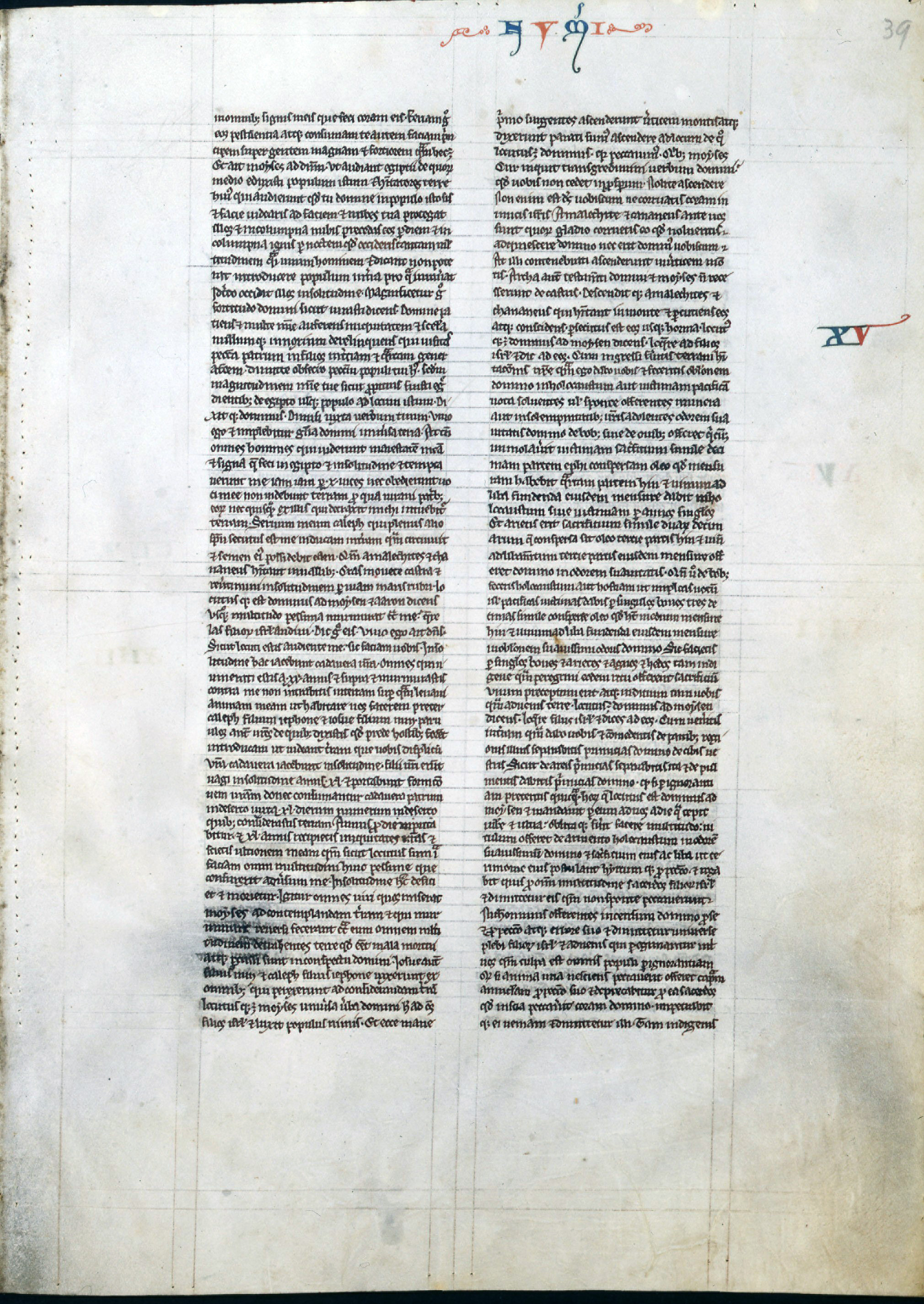
A Bible from the 12th century contained hundreds of pages whose script was one-sixteenth of an inch high. Evidently the devotional act was as much or more in the creation of the text than in the reading of it. An enlargement shows the accuracy of the script at that scale:
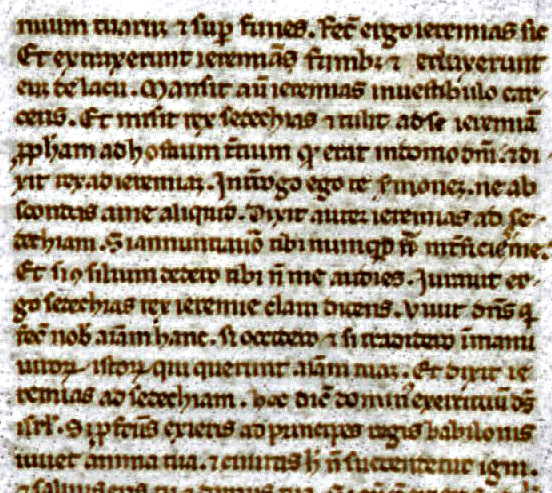
Fine filigree penmanship was everywhere:
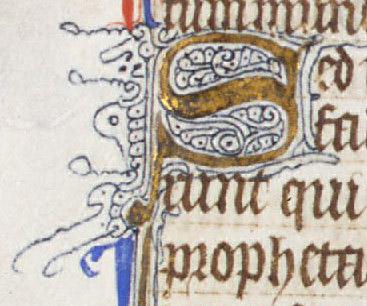
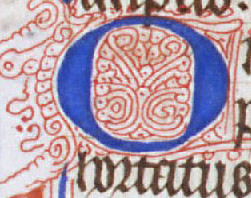
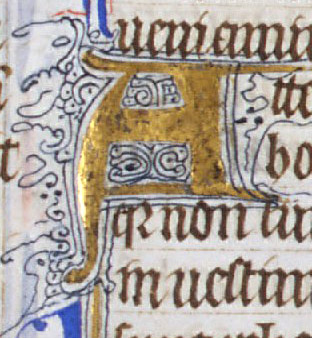
Other details proved equally fascinating:
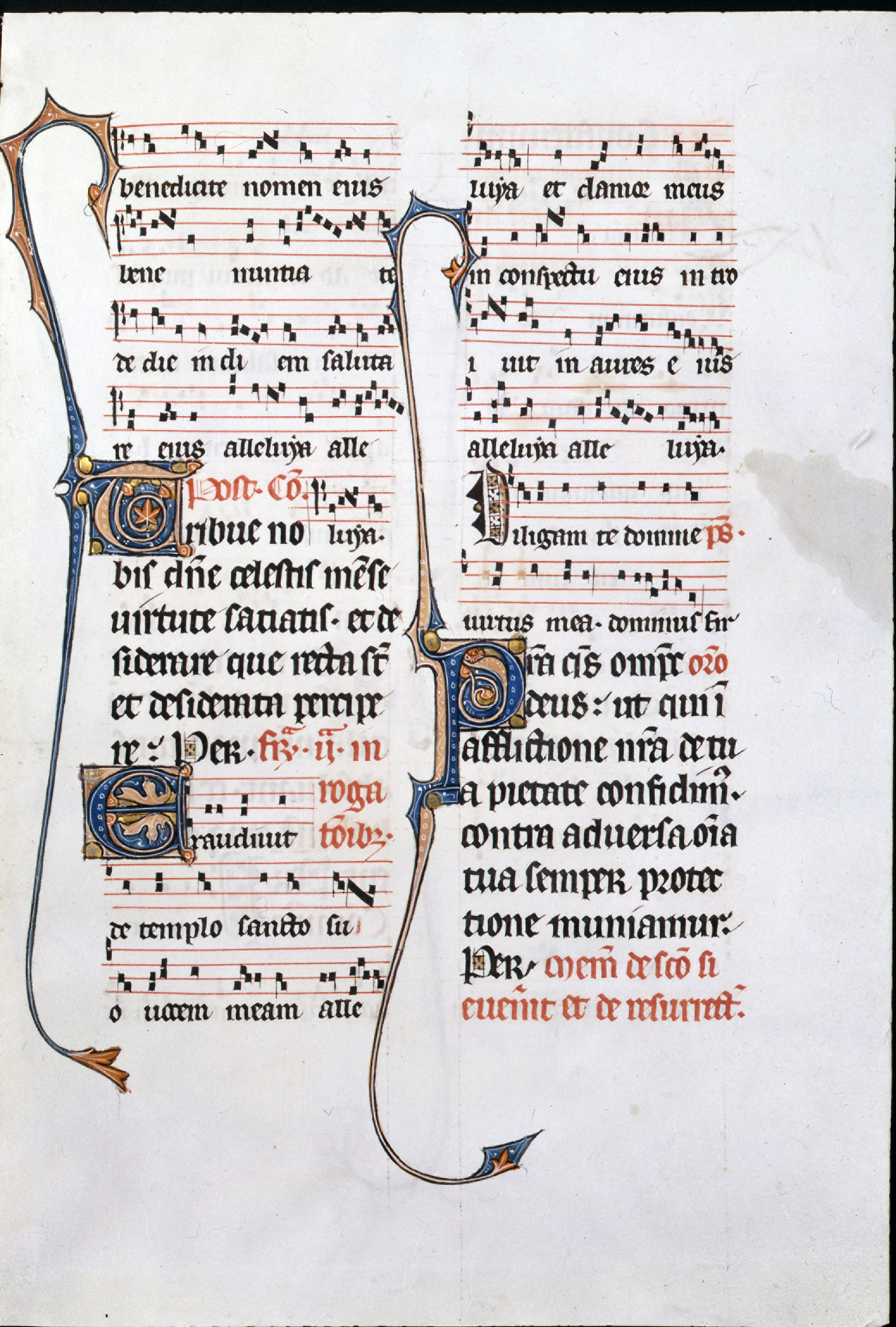

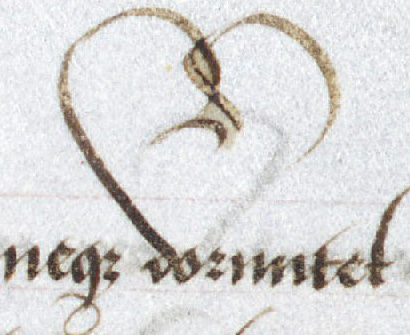
These details, in fact, were the focus of book-tearers until toward the end of the 19th century. Initials or other visually attractive elements would be removed and sold or saved while the rest of the leaf would be thrown away. Christopher de Hamel argues that these habits changed quite suddenly at the end of the nineteenth century and the beginning of the 20th, presaged in part by John Ruskin.8 Otto Ege, part of a long line of book-tearers that stretched back hundreds of years, found it inappropriate to remove an initial, miniature or other detail: for him, in the first decades of the 20th century, the leaf, not the book, was a sacrosanct item to be preserved and the chief unit of interest .
The book, however, was another story. In fact, any story that the book -- The Book -- told was already well-known. Why preserve it? The page was the significant unit of interest; its relationship to a group of other pages called a book was a predictable one that, in the case of the Bible, revealed little to us we didn’t already know. Every Bible could be more or less the same. Every page, though, was quite different, depending on its provenance. In a way, the Ege box was a new form of the book, arranging a roughly chronological story of the page from the 1100s to about a century beyond the invention of the printing press.
Which takes us to the next point: reuniting the scattered leaves of Otto Ege’s collection with their original siblings. Why bother doing this? In one way, it’s a simple human reflex, like picking up the pieces of a broken pot and putting them back together. In another way, it’s a simple book-lover’s reflex -- somebody took these books apart and somebody shall put them back together again. In yet another way, it speaks to the fetish of the book that the later twentieth century and beyond has witnessed -- a kind of nostalgia for the intact original book that pre-dates the mass production ushered in by the printing press.
But our motivation, I think, is different from these. Just as the focus on the page revealed understandings that were not as available to us when our attention was distracted by the book, so might one of Ege’s original medieval books tell us something more than the leaf itself. If so, one has to choose carefully what book to bother trying to recover, as it were. It’s not unlike the principle behind intelligent hypertext editing: not all texts will yield something new when placed in a digital environment. Not all Ege leaves are worth putting back together again.
Probably the most remarkable book in Ege’s collection of dismembered books is the Beauvais Missal. He purchased it apparently intact from the Brölemann sale at Sotheby’s, May 5th 1926.9 A bequest inscription in Latin, transcribed in the Sotheby’s catalogue, contained the information that Robert de Hangest, canon of Beauvais Cathedral, “whose anniversary was to be commemorated on the 3rd of November, gave the manuscript as a bequest to Beauvais Cathedral” in 1285.10 The autograph inscription is now lost but is the reason for the manuscript being referred to as the Beauvais Missal.
One of the interesting features of this page is its ivy branch images: Ege, in his explanatory card called it the first ivy branch “to put forth its ...leaves in the history of ornament. The writing, likewise, is departing from its previous rigid character and displays an ornamental pliancy which harmonizes with the decorative initials”.11 (A lot of this is probably inaccurate: the ivy branch made an appearance on the medieval page prior to the Beavais Missal’s creation, for example.)

In each Ege box that we’ve located (about 32 now, including most recently #1 privately owned in Chicago) the Beauvais Missal is leaf #15. Many of these we’ve found through digitized university library catalogued entries, mostly in North America. Some we’ve found because other people had similar ideas, most notably at the University of Colorado, Boulder; Denison University in Ohio; Yale; and the Rochester Institute of Technology. The Digital Scriptorium under the direction of Consuelo Dutschke, Denison through Fred Porcheddu, Yale through Barbara Shailor, the Ontario College of Art and Design through Jill Patrick, the Art Gallery of Ontario, and Massey College at the University of Toronto through Marie Korey and Richard Landon, have been involved in searching for the other leaves.
Some we’ve found because the media picked up on the story, people read about it or heard about it, and got in touch with us to say they thought they possessed an Ege leaf. Many were incorrect, but every once in a while someone did in fact have one. A private collector sent images this year of two Beauvais leaves given to his mother in 1930 by Ege. Recently, a bookseller in Chicago heard about the project and wrote to me with a long description of Ege box #1 which he had sold to a private collector who would not reveal his identity. Two Beauvais Missal leaves were for sale at the annual meeting of the Medieval Institute at Western Michigan University at Kalamazoo in 2001. A variety of leaves were for sale on eBay. Then an article appeared in the Maine Antique Digest in November 2006 titled “My Ege was Rejected”: the theme was the patronizing and authoritative stance of institutional libraries versus the friendly community of private amateur collectors. (That article begins with a wonderful example of misinformation: “In 2000 the University of Saskatchewan in Saskatoon, Saskatchewan, Canada was renovating its library and discovered a folio that the university had purchased in the 1930's for $750.” We were not renovating our library, and we purchased the box, not just a folio, in 1957, not the 1930s.) The article’s author goes on to write that the hunt for missing Ege folios is referred to as “the Ege puzzle,” and the U.K. has adopted this as a national part-time hobby [the UK?]. Not many appear on the open market, which is ironic since they were scattered all over the world. No one really knows how many are still unaccounted for. Anyone can buy a magnificent medieval manuscript for the right price, but not an Ege. When one does appear, there is a howl from the ivory tower regarding its rights to first dibs.12
History Television sent a film crew to the University of Saskatchewan for two days of filming -- the host was Jeff Douglas, formerly famous for being the “Hi, my name is Joe and I am Canadian” frontman for Molson’s Canadian breweries tv advertisements. The documentary was aired on television in December 2007. A seemingly endless blog started after we mounted the Scattered Leaves exhibit two years ago and put the images on the web: it contains opinions such as: “In hell Otto Ege and Company are unseamed and sold to a thousand fat demons from whom they must buy back the bits with vile acts and stitch themselves together. Then the demons rip them apart again”. From the opposite perspective, someone proposed that “in a way it’s like tearing apart a Penguin paperback of Dickens.” Clearly Ege struck a nerve that indicated an enormous cultural interest in the Ege documents, and his decisions about how to disseminate them.
Why should a disbound and dispersed Ege book be reconstructed? First, the reconstruction would be digital and virtual. Much as we would love to have people send us their actual Beauvais Missal leaves, the fact that the collector in Chicago with Box #1 won’t even reveal his name suggests it’s not likely. But the digitized edition of the Beauvais Missal would have its benefits beyond the physical book. Its availability on the web would complement rather nicely Ege’s original motive for dismembering books and selling the boxes. Beauvais Missal leaf owners, many of whom are unaware of the original book context of their possession, could have the opportunity to collaborate in the project of recreating it. The incremental re-composition of the book would be a work in progress that everyone could follow, a kind of unfolding narrative moving to completion. Using a Flash program to simulate the turning of the pages for the user would avoid the potential damage from turning the pages of the actual book.
To be a little more provocative, let’s recognize what we’re not going to achieve. There’s no binding for this book in existence that we know of. There’s the colophon page whose location is not known after the Sotheby’s sale, but really we’re assembling leaves, not a complete book. The page will still be the unit of attention as a result, though at times the verso and recto pages work together as a simultaneous visual unit forming an important relationship as John Dagenais and others have shown.13 To remake the book would yield new knowledge only if the relationship between or among leaves told us something the individual leaves do not. If it does, it will in ways as yet unclear to us. We often erroneously equate the book with the novel, a piece of technology whose meaning does depend on its intact narrative state. As I’ve argued here, though, the story of these medieval texts is told mostly through the page, not the book. There might be an originary intention that the intact codex can recover for us, but authorial intention in these cases was multiple to begin with, and at the level of the individual page’s labour and devotion, not at the level of textual completeness. Otto Ege in fact confuses the relationship between the page and the book here. His explanatory note attached to the cardboard frame of each page is the same for each page’s relative in every box. It refers to the book from which the page was removed, not to the individual page itself. Of the Beauvais Missal, for example, he writes:
This manuscript, a special gift to a church in the city of Beauvais, was written for Robert de Hangest, a canon, about 1285 A.D. At that time, Beauvais was one of the most important art centres in all Europe. The ornament in this leaf shows the first flowering of Gothic interest in nature. The formal hieratic treatment is here giving way to graceful naturalism. The ivy branch has put forth its first leaves in the history of ornament. The writing, likewise, is departing from its previous rigid character and displays an ornamental pliancy which harmonizes with the decorative initials.
Although Ege writes “the ornament in this leaf” he is not in fact referring to the specific page to which the description is attached: this description is identical on all leaf #15s in all the boxes we have seen so far. And when he writes “this manuscript” he means the book itself, not the page. The students curating the Scattered Leaves exhibit in the Snelgrove Gallery soon had to come to terms with this discrepancy. Their descriptions are specific to the individual page in front of the viewer, and consequently differ substantially from Ege’s. In fact, Ege was frequently quite wrong about dates, scripts and locations, something else the students had to try to correct. And reconstructing a book can of course assist with the necessary accuracy one strives for in this regard: one page might hold a clue to its book’s provenance that another of its pages might not.
Conceptualizing all this depends upon terminology, similar to how we use words to describe Ege’s “removal” of leaves. We shouldn’t think of the book as the simulacrum of completeness or of the page as a fragment or, at least, of the page as a fragment in the sense of lost wholeness. The modernist enterprise of reinterpreting the fragment as a trace of indelible meaning, not as a nostalgic example of an irrecoverable unified past, through Pound and so many others, can assist here. The page can be rethought the same way. The deep and immediate public response (abhorrence and curiosity) to Ege’s removal of leaves tells us that the Romantic notion of the fragment, and of the page as a fragment of a lost whole (the originary book) is as strong as ever. “The great goal of recovery -- of authorial intention or of the genealogy of a text through the traced history of its material manifestations -- these are mere surface features, distractions, the one ill-conceived and the other excruciatingly executed.”14 But to the public and the media for whom Ege’s story is most compelling, the great goal of recovery is the focus, the fragment as leaf is the loss.
In a curious way, Ege’s project of scattered leaves demands attention be given the page and probes the often unquestioned primacy of the book in a very public way. Much as I would like to rescue Otto Ege from the thousand fat demons that tear him apart, his scattered leaves tell us that the “book” is not necessarily the operative unit. In the end, reconstructing it will challenge our assumption that it is.
1 Beatrice Warde, "The Crystal Goblet or Printing Should Be Invisible" in The Crystal Goblet: Sixteen Essays on Typography (Cleveland: World Publishing Company, 1956): 11-17.
2 For a consideration of the page’s complexity, see Peter Stoicheff and Andrew Taylor, eds. The Future of the Page (Toronto: University of Toronto Press, 2005).
3 In his book Liber Abaci (1202) the mathematician Fibonacci (Leonardo of Pisa) explains the sequence of numbers attributed to him in the 19th century. The sequence is created by adding two adjacent numbers whose sum becomes the third number: 0,1, 1, 2, 3, 5, 8, 13 etc. Many phenomena in nature illustrate it (the relative lengths of bones in the fingers, hand and arm; the number of births in a year from one pair of rabbits and their descendants) and in ancient and classical architecture. Medieval scribes frequently designed the dimensions of the text on a page to conform with the ratio between any two adjacent numbers, as did Gutenberg for his Bibles. See one aspect of the University of Saskatchewan’s digital Ege exhibit “Scattered Leaves” for a fuller treatment of this (http://library2.usask.ca/ege/exhibit/30.htm).
4 Barbara Shailor, “Otto Ege: His Manuscript Fragment Collection and the Opportunities Presented by Electronic Technology”, Journal of the Rutgers University Libraries (LX. 2003): 2.
5 Otto Ege, “I Am a Biblioclast” Avocations (March 1938): 518.
6 Shailor, “Otto Ege”: 10
7 http://library2.usask.ca/ege/exhibit/
8 See Christopher de Hamel, “Cutting Up Manuscripts for Pleasure and Profit.” The Rare Book School 1995 Yearbook, ed. Terry Belanger (Book Arts Press, University of Virginia, Charlottesville: March 1996): “... Ruskin was not a snipper-out of miniatures, and his admiration was for the whole page, including script and borders. ... By about 1900, we begin to find a new type of collector, interested not just in illumination but in whole leaves” (15).
9 Christopher de Hamel, “Cutting Up Manuscripts for Pleasure and Profit.”:18. Shailor, “Otto Ege” 9.
10 Shailor, “Otto Ege” 9.
11 http://www.umilta.net/ege.html
12 Joanie Rothstein, “My Ege Was Rejected” <http://www.maineantiquedigest.com/articles/nov06/f-ege1106.htm>
13 John Dagenais, “Decolonizing the Medieval Page” in Stoicheff and Taylor, The Future of the Page.
14 Johanna Drucker, “Excerpts and Entanglements”, paper presented at the Document Academy meeting in Berkeley, SIMS, August 13, 2003.
DAGENAIS, John. (2005). “Decolonizing the Medieval Page” in The Future of the Page, (eds. Peter Stoicheff and Andrew Taylor), Toronto: University of Toronto Press: 37-70.
DRUCKER, Johanna. (2003). “Excerpts and Entanglements”, paper presented at the Document Academy meeting in Berkeley, SIMS, August 13, 2003.
EGE, Otto. (1938). “I Am a Biblioclast”, Avocations (March): 518.
FIBONACCI (Leonardo of Pisa). (1202). Liber Abaci.
de HAMEL, Christopher. (1996). “Cutting Up Manuscripts for Pleasure and Profit”, The Rare Book School 1995 Yearbook, (ed. Terry Belanger), Charlottesville, VA: Book Arts Press, University of Virginia.
ROTHSTEIN, Joanie. (2006). “My Ege Was Rejected”, Main Antique Digest, (URL http://maineantiquedigest.com/articles_archive/articles/nov06/f-ege1106.htm).
“Scattered Leaves: the Otto Ege Medieval Manuscript Collection,” an exhibit at the Gordon Snelgrove Gallery, June 7-23 2005, University of Saskatchewan,(URL http://library2.usask.ca/ege/exhibit/).
SHAILOR, Barbara. (2003). “Otto Ege: His Manuscript Fragment Collection and the Opportunities Presented by Electronic Technology”, Journal of the Rutgers University Libraries 60: 2.
STOICHEFF, Peter and Andrew TAYLOR, eds. (2005). The Future of the Page, Toronto: University of Toronto Press.
WARDE, Beatrice. (1956). “The Crystal Goblet or Printing Should Be Invisible”, The Crystal Goblet: Sixteen Essays on Typography, Cleveland: World Publishing Company: 11-17.